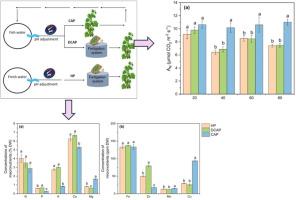耦合和解耦水培系统栽培黄瓜的生理和生长动态
IF 4.2
2区 农林科学
Q1 HORTICULTURE
引用次数: 0
摘要
解耦水培是一个新兴的研究领域,由于它有可能克服耦合(单环)水培系统中确定的限制,从而提高作物生产力,因此引起了人们的兴趣。本研究采用生理学方法来阐明耦合(CAP)和解耦(DCAP)水培系统中黄瓜生长响应的机制,并与传统水培(HP)系统进行比较。在一个中试规模的水培温室中进行了为期90天的实验,在那里详细和定期地测量各种生理和生长参数,以捕捉它们的动态。此外,还对果实品质参数进行了评价,以完成对试验种植制度的评价。CAP植物在空中生物量积累和叶面积方面表现出发育迟缓,而叶片厚度和叶比质量等解剖特征显著高于HP和DCAP植物。但不同处理的光合性能、光能利用效率和光合色素浓度基本相同。叶片元素分析表明,充足的N和Fe浓度支持较高的光合速率,而降低的K、P和Zn水平影响了CAP植株的生长特征。在几乎所有被评估的特性中,DCAP表现出与HP相当的性能。总的来说,结果表明DCAP解决了与耦合系统相关的局限性,表明其支持传统水培向更可持续的种植系统过渡的巨大潜力。本文章由计算机程序翻译,如有差异,请以英文原文为准。

Capturing the physiological and growth dynamics of cucumber cultivated in coupled and decoupled aquaponic systems
Decoupled aquaponics, an emerging area of research, has garnered interest due to its potential in overcoming the constraints identified in coupled (one-loop) aquaponics systems, thereby enhancing crop productivity. The present study employs a physiological approach to elucidate the mechanisms underlying the growth responses of cucumber in both coupled (CAP) and decoupled (DCAP) aquaponics systems, in comparison to conventional hydroponics (HP). A 90-day experiment was conducted in a pilot-scale aquaponics greenhouse, where detailed and regular measurements of various physiological and growth parameters were taken to capture their dynamics. Additionally, fruit quality parameters were assessed to complete the evaluation of the tested cropping systems. CAP plants exhibited stunted growth in terms of aerial biomass accumulation and leaf area, while anatomical features such as leaf thickness and leaf specific mass were significantly higher than those observed in HP and DCAP plants. However, the photosynthetic performance, the light use efficiency, and the photosynthetic pigments concentration were comparable among treatments. The leaf elemental analysis revealed that adequate N and Fe concentrations supported high photosynthetic rates, however, the reduced K, P and Zn levels influenced the growth profile of CAP plants. DCAP demonstrated comparable performance to HP in almost all the evaluated characteristics. Collectively, the results indicate that DCAP addressed limitations associated with coupled systems, indicating its significant potential to support the transition of conventional hydroponics towards a more sustainable cropping system.
求助全文
通过发布文献求助,成功后即可免费获取论文全文。
去求助
来源期刊

Scientia Horticulturae
农林科学-园艺
CiteScore
8.60
自引率
4.70%
发文量
796
审稿时长
47 days
期刊介绍:
Scientia Horticulturae is an international journal publishing research related to horticultural crops. Articles in the journal deal with open or protected production of vegetables, fruits, edible fungi and ornamentals under temperate, subtropical and tropical conditions. Papers in related areas (biochemistry, micropropagation, soil science, plant breeding, plant physiology, phytopathology, etc.) are considered, if they contain information of direct significance to horticulture. Papers on the technical aspects of horticulture (engineering, crop processing, storage, transport etc.) are accepted for publication only if they relate directly to the living product. In the case of plantation crops, those yielding a product that may be used fresh (e.g. tropical vegetables, citrus, bananas, and other fruits) will be considered, while those papers describing the processing of the product (e.g. rubber, tobacco, and quinine) will not. The scope of the journal includes all horticultural crops but does not include speciality crops such as, medicinal crops or forestry crops, such as bamboo. Basic molecular studies without any direct application in horticulture will not be considered for this journal.
 求助内容:
求助内容: 应助结果提醒方式:
应助结果提醒方式:


